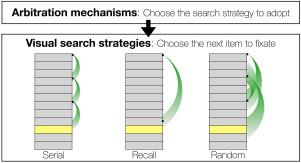模拟菜单搜索策略是如何随着经验发展的
IF 5.1
2区 计算机科学
Q1 COMPUTER SCIENCE, CYBERNETICS
International Journal of Human-Computer Studies
Pub Date : 2025-08-31
DOI:10.1016/j.ijhcs.2025.103615
引用次数: 0
摘要
为了在菜单中找到一个项目,用户可以遵循不同的视觉搜索策略,例如逐个扫描项目(串行搜索)或尝试记住项目的位置(回忆搜索)。然而,建立搜索行为的预测模型被证明是具有挑战性的,因为这些策略随着实践而发展。为了解决这一挑战,我们研究了线性菜单中视觉搜索的理论启发模型,并提出了一种新的仲裁机制来协调这种视觉搜索策略的采用。给定一个菜单设计和用户以前使用它的经验,我们的方法可以预测何时采用不同的搜索策略(连续、召回、随机),以及下一个会关注哪个菜单项。我们的研究结果(1)用心理学上有效且可解释的模型合理地描述了经验数据,(2)为搜索策略如何随着实践而演变提供了新的见解,(3)展示了如何从眼动追踪数据推断搜索策略。综上所述,这些模型为更好地理解用户如何学习扫描线性菜单提供了基础。本文章由计算机程序翻译,如有差异,请以英文原文为准。

Modeling how menu search strategies develop with experience
To find an item in a menu, users can follow different visual search strategies, such as scanning items one by one (serial search) or trying to remember where the item was (recall search). However, building predictive models of search behavior has turned out to be challenging, because these strategies evolve with practice. To address this challenge, we study theory-inspired models of visual search in linear menus and propose a novel arbitration mechanism to coordinate the adoption of such visual search strategies. Given a menu design and the user’s previous experience with it, our approach predicts when different search strategies (serial, recall, random) will be adopted and which menu item will be fixated next. Our results (1) describe empirical data plausibly with psychologically valid and interpretable models, (2) provide new insights about how search strategies evolve with practice, and (3) show how to infer search strategy from eye tracking data. To sum up, the models provide a foundation to better understand how users learn to scan linear menus.
求助全文
通过发布文献求助,成功后即可免费获取论文全文。
去求助
来源期刊

International Journal of Human-Computer Studies
工程技术-计算机:控制论
CiteScore
11.50
自引率
5.60%
发文量
108
审稿时长
3 months
期刊介绍:
The International Journal of Human-Computer Studies publishes original research over the whole spectrum of work relevant to the theory and practice of innovative interactive systems. The journal is inherently interdisciplinary, covering research in computing, artificial intelligence, psychology, linguistics, communication, design, engineering, and social organization, which is relevant to the design, analysis, evaluation and application of innovative interactive systems. Papers at the boundaries of these disciplines are especially welcome, as it is our view that interdisciplinary approaches are needed for producing theoretical insights in this complex area and for effective deployment of innovative technologies in concrete user communities.
Research areas relevant to the journal include, but are not limited to:
• Innovative interaction techniques
• Multimodal interaction
• Speech interaction
• Graphic interaction
• Natural language interaction
• Interaction in mobile and embedded systems
• Interface design and evaluation methodologies
• Design and evaluation of innovative interactive systems
• User interface prototyping and management systems
• Ubiquitous computing
• Wearable computers
• Pervasive computing
• Affective computing
• Empirical studies of user behaviour
• Empirical studies of programming and software engineering
• Computer supported cooperative work
• Computer mediated communication
• Virtual reality
• Mixed and augmented Reality
• Intelligent user interfaces
• Presence
...
 求助内容:
求助内容: 应助结果提醒方式:
应助结果提醒方式:


